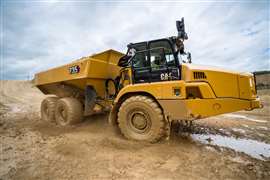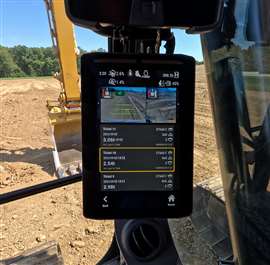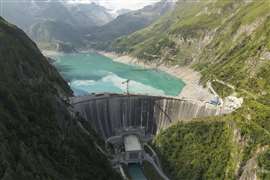Read this article in Français Deutsch Italiano Português Español
Caterpillar urges construction to embrace technology as an enabler, not a threat
28 October 2025
 Caterpillar’s updated 735 articulated dump truck (Image courtesy of Caterpillar)
Caterpillar’s updated 735 articulated dump truck (Image courtesy of Caterpillar)
At Caterpillar’s Demonstration and Learning Centre in Málaga, Spain, the focus was firmly on technology.
Over two days, Construction Briefing joined dealers and contractors from all over Europe, Africa and the Middle East who had gathered to see a range of systems in action, from Cat Detect with Motion Inhibit and Cat Payload, to Assist features, Cat Command remote control, VisionLink connectivity and Cat Grade with 3D.
The message was clear: these tools are no longer experimental add-ons, but increasingly central to how jobsites are managed. After the demonstrations, Construction Briefing spoke with Chih Liang, Caterpillar’s vice president of global construction technology sales and marketing, about where the industry stands on adoption and why operators should not fear what is coming.
No longer an add-on
Spending on technology in construction remains relatively low compared to other industries.
 Chih Liang, Caterpillar’s vice president of global construction technology sales and marketing (Image courtesy of Caterpillar)
Chih Liang, Caterpillar’s vice president of global construction technology sales and marketing (Image courtesy of Caterpillar)
A 2023 McKinsey study presented during the event suggested contractors invest around 1–2% of revenue in technology, versus 3–5% in other sectors. Liang acknowledged that construction’s historical caution played a role but said the main challenge lies in how firms approach investment.
“With their investments, it’s not just systems and tools, but also the people,” he said. “If they’re looking to increase productivity, they expect a return, whether that’s addressing labour shortages, improving efficiency, or enhancing safety. All those elements come into play. And people change management is also very important.”
For Caterpillar, helping customers build confidence in the business case is a priority as it can help solve some of their biggest challenges. The Malaga event itself was part of that effort.
“If you have never had the opportunity to encounter the technology, you don’t always know what’s possible,” Liang explained. “Our job is to show customers what’s possible. And Caterpillar will never cease innovating: That’s why we’re here to continue to serve our customers, listen to them and enable them to be successful.”
Evidence of momentum is visible in VisionLink, which now tracks 1.5 million connected assets worldwide. The data allows contractors to benchmark performance and identify ways to improve utilisation and efficiency. Crucially, Liang stressed, it is enabling customers to use it. “It’s about them understanding the data that is available to make the job site better and improve on it,” he noted.
The diversity of Caterpillar’s technology portfolio reflects the varied pace of adoption globally. In some regions, contractors are focused on assist features that make operating easier. In others, remote operation and autonomy are already on the agenda.
“Depending on the level of adoption in the country or the region, our customers look at different parts of the portfolio,” Liang said. “We want to make sure they know what technology is right for them, and we have the portfolio to solve customers’ biggest challenges.””
Full autonomy on construction sites remains further away than in more controlled environments such as quarrying or mining. The unpredictability of earthmoving jobsites makes it harder to achieve repeatability. Liang declined to forecast when autonomy might become common but noted, “With autonomy in construction, it’s not a matter of if, it’s probably a matter of when.”
Why operators needn’t fear technology
 Caterpillar has updated its hydraulic excavator user interface (UI) to allow for more rapid access to setup, work tool reordering and coupling configurations (Image: Cat)
Caterpillar has updated its hydraulic excavator user interface (UI) to allow for more rapid access to setup, work tool reordering and coupling configurations (Image: Cat)
One concern that often surfaces is whether operators feel threatened by these advances. Liang argued the opposite should be true. “We want to offer choices to the operators and to the customers. These features can help to make your life easier and potentially your job safer. And we want to upskill them - knowing technology, understanding it, and using it will always make them more valuable.”
The construction industry’s well-documented labour shortages add weight to that point. With many experienced operators nearing retirement, new entrants (often digital natives) may be quicker to adopt technology. “We anticipate the next generation will be more favourable to adopting technology because that’s what they’re already doing today,” Liang said.
Looking ahead, he sees the next five years as a continuation of existing pressures around productivity, efficiency, safety and workforce capacity, particularly in infrastructure. Building infrastructure is typically part of making progress and improving quality of life,” he said. “So there will be inherent demand for construction, and Caterpillar wants to be part of helping contractors meet it in a sustainable way.”
For firms considering their next steps, Liang’s advice was to start small and measurable. “Understand the data you already have, identify areas you want to improve, whether that’s productivity or fuel efficiency, and test it. Take a before and after, and see the results. Then expand from there,” he recommended.
STAY CONNECTED


Receive the information you need when you need it through our world-leading magazines, newsletters and daily briefings.
CONNECT WITH THE TEAM











